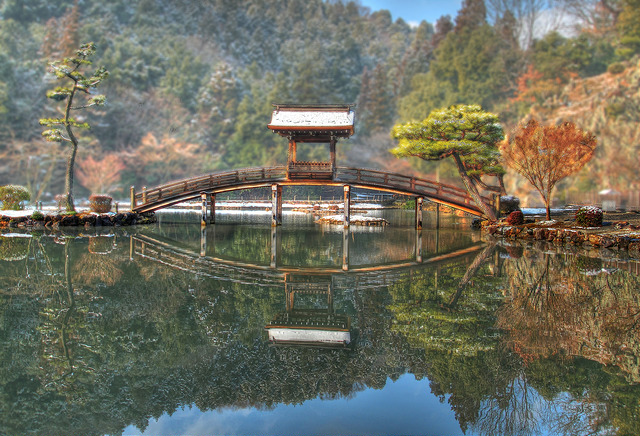Dec 26, 2018
Day trips from Nagoya – Tajimi, Gifu

Just over the border from Aichi into Gifu Prefecture is the town of Tajimi, an area renowned for its ceramic manufacture, great natural beauty and peaceful streets. Being just 40 minutes by train from Nagoya it is an excellent destination for a day trip
Tajimi’s Famous Ceramics
With clay in the surrounding hills, there has been pottery manufacture in Tajimi for some 1,300 years, evidence of which can be seen the moment you step into the train station to be greeted by an immense ceramic wall. Outside of the station and across the Tokigawa River you come to Honmachi Oribe, a Meiji era street with its black and white wooden houses that has been the center of Tajimi’s ceramics industry since those times.
The street, named after famed feudal-era tea master Furuta Oribe, is home to a number of shops trading in pottery and ceramics, with the local green-glazed Mino-yaki style particularly prevalent. From reasonably-priced souvenirs to more expensive works of art, you can find something for all tastes, and April sees more than 50 producers selling their wares during a ceramics festival.

Some of the old houses have been reconfigured as small museums, and if you want to learn more about the craft, a ten minute bus journey from the station takes you to Ceramic Park Mino. Here you can shop and try your hand at making your own pottery as well as exploring the Museum of Modern Ceramic Art and the Gifu Prefectural Ceramic Museum.
20 minutes by bus from Tajimi station is Tajimi Mosaic Tile Museum, displaying some 10,000 examples of tile production throughout history. However, the most impressive aspect of the museum is the building itself. Designed by Fujimori Terunobu, it is a great example of blending architecture with nature, as it rises like a terracotta anthill from the grounds.

Eihoji Termple
Built in 1313, Eihoji is a serene spot of tranquility, and perhaps Tajimi’s greatest manmade beauty spot. The Zen Buddhist temple sits amongst gardens that reflect the seasons, turning the plump pink of cherry blossoms in spring, the gorgeous golds of maple trees in autumn and elegant snow-dappled whites in winter.
The temple overlooks a large pond in which koi carp glide peacefully below arched bridges, and the air of tranquility is enhanced by chanting of the studying monks in the meditation room situated beside a waterfall that cascades into the pond below.

The temple is found by way of a winding old path through cedar groves and bamboo copses, where you can discover small buddhist Jizo statues. Eventuallt the path leads up through the hills affording stunning views of the area.
Tajimi Catholic Monastery
Zen Buddhism is not the only religion represented in Tajimi. Built by German Catholic missionaries led by Father Mohr, the Tajimi Monestary holds an English Mass on the second and fourth Sunday of the month.

The building is striking, and is immediately recognizable for its northern European style and its imposing spire. But perhaps above the architecture, the Tajimi Monastery is best known for its vineyard and wine production. A wine festival is held each November, but the locally produced wine can be purchased all year round and makes for a great souvenir.
1 comment so far
Day trips from Nagoya – Tajimi, Gifu | LikeNagoya.comPosted on5:38 pm - Jan 25, 2019
[…] Just over the border from Aichi into Gifu Prefecture is the town of Tajimi, an area renowned for its ceramic manufacture, great natural beauty and peaceful streets. Being just 40 minutes by train from Nagoya it is an excellent destination for a day trip Tajimi’s Famous Ceramics With clay in the surrounding hills, there has been pottery manufacture in Tajimi for some 1,300 years, evidence of which can be seen the moment you step into the train station to be greeted by an immense ceramic wall. Outside of the station and across the Tokigawa River you come to Honmachi Oribe, a Meiji era street with its black and white wooden houses that has been the center of Tajimi’s ceramics industry since those times. The street, named after famed feudal-era tea master Furuta Oribe, is home to a number of shops trading in pottery and ceramics, with the local green-glazed Mino-yaki style particularly prevalent. From reasonably-priced souvenirs to more expensive works of art, you can find something for all tastes, and April sees more than 50 producers selling their wares during a ceramics festival. Some of the old houses have been reconfigured as small museums, and if you want to learn more about the craft, a ten minute bus journey from the station takes you to Ceramic Park Mino. Here you can shop and try your hand at making your own pottery as well as exploring the Museum of Modern Ceramic Art and the Gifu Prefectural Ceramic Museum. 20 minutes by bus from… ———————————————————- Day trips from Nagoya – Tajimi, Gifu Original Source: http://www.JapanInfoSwap.com Day trips from Nagoya – Tajimi, Gifu […]


About the author